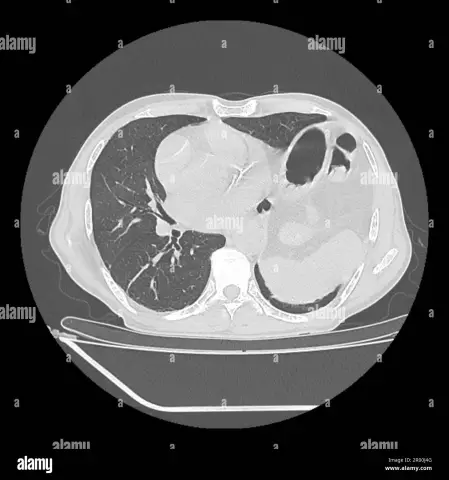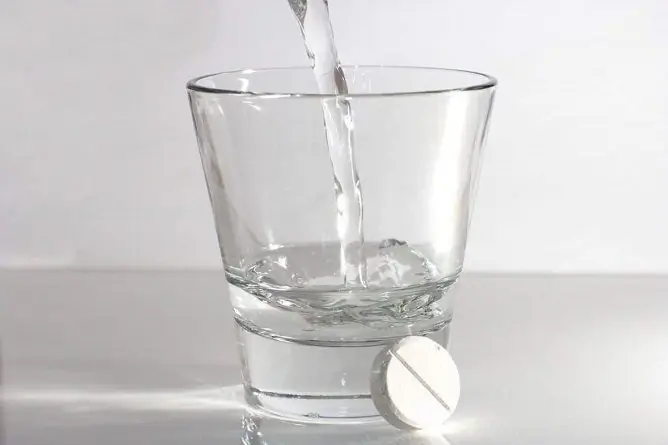- Author Rachel Wainwright [email protected].
- Public 2024-01-15 19:51.
- Last modified 2025-11-02 20:14.
Spinal block with hernia
The content of the article:
- Kinds
- General principles
- Indications and contraindications
- Drugs
- Procedure rules
- Effects
- Is it dangerous to do
- Video
A spinal block with a hernia is a procedure that is performed to eliminate radicular pain and refers to a palliative treatment option, that is, it does not eliminate the disease itself, but only relieves the symptom. The procedure is also aimed at improving the emotional state against the background of the underlying disease, since prolonged pain can cause depression, as a result, the body's response to therapeutic measures will significantly worsen.

Blockades can effectively eliminate pain syndrome in cases where oral administration of painkillers is ineffective
Kinds
There are two types of blockades:
- therapeutic - it is used, despite possible complications, quite often;
- selective - it is used as a method of differential diagnosis of similar diseases when instrumental and laboratory studies are not informative.
Classification by localization of injection and method of exposure to tissue:
- interstitial - injection directly into the dystrophically altered part of the disc;
- impact on receptor fields (intradermal, intramuscular, periarticular, subperiosteal, intraosseous, perivascular);
- conductive (epidural, epidural, radicular, plexus, perineural);
- ganglionic - in the intervertebral node.
General principles
- It is a semi-surgical treatment technique and is carried out strictly in a dressing room. Requires the patient's written consent.
- A prerequisite is the absence of a history of allergic reactions to the drug.
- The drug is administered taking into account anatomical and topographic landmarks.
- The composition of the medicinal mixture is selected taking into account the characteristics of the disease and its duration, as well as instrumental data in each case.
- The duration and frequency of the procedure depend on the reaction to the drug (instrumental control over the course of the hernia and correction of treatment, if necessary, are required). In the absence of a visible effect from 2-3 blockades, a change in treatment is indicated.
Indications and contraindications
Hernia blockade serves as the first stage in the treatment regimen; the hernial protrusion itself is eliminated after effective pain relief.
This method of treatment is used in the presence of a number of symptoms that cause severe disability.
Indications:
- severe pain and radicular syndrome;
- prolonged muscle spasm;
- severe impaired mobility of the spine;
- spondyloarthralgia;
- neurodystrophic changes in muscles, ligaments, osteoarticular apparatus;
- vegetative-vascular compression and reflex-neurodystrophic disorders;
- vertebro-visceral and viscero-vertebral syndromes.
Contraindications:
- an allergic reaction to the drug;
- purulent processes directly in the area of conduct;
- inflammatory and infectious processes of general genesis;
- lesions of the central nervous system of various origins;
- diabetes mellitus in the stage of decompensation;
- any chronic processes in the stage of decompensation;
- pregnancy;
- disorders of the cardiovascular system (bradycardia, hypotension);
- epileptic status.
Drugs
There is a whole list of drugs that are used for blockades (they differ in the mechanism of action):
- painkillers - analgesics and antipsychotics of different groups;
- muscle relaxants - central muscle relaxants, tranquilizers, botulism toxin;
- sclerosing - alcohol, carbolic acid;
- resorbing and prolonging - proteolytic enzymes, GCS;
- stimulating metabolic processes - vitamins, amino acids, biogenic stimulants;
- vasoregulatory - vasodilators, venotonics, ganglion blockers, adrenergic blockers, adrenoreceptor stimulants.
By the number of simultaneously administered drugs:
- one-component;
- multicomponent.
Depending on the frequency of administration:
- single use;
- multiple (daily, weekly, coursework).
By the rate of introduction:
- full dose of the drug, simultaneously injected into the spinal canal or other required area;
- the drug is administered in portions through a catheter over several hours or days.
Local anesthetics include:
| A drug | Dosages, action |
| Novocaine | Novocaine blockade is used in the form of solutions of 0.25%, 0.5%, 1% and 2%. The duration of the action is 1-3 hours. The person begins to feel the effect within 2-5 minutes after administration. |
| Lidocaine | For infiltration anesthesia, 0.125%, 0.25% and 0.5% are used (maximum dose of 60 ml of 0.5% solution). For conduction anesthesia, 1% and 2% solutions are used (the maximum dose is up to 40 ml of 1% solution or 20 ml of 2% lidocaine solution). For nerve plexus blockade 10-20 ml of 1% solution or 5-10 ml of 2% solution. Faster than novocaine (1-2 min). |
| Mercain | It is a strong local anesthetic with a duration of up to 3-6 hours. It differs from the previous options in the long onset of anesthesia (10-20 minutes). |
Procedure rules
The drugs should be administered in accordance with the rules of asepsis and antisepsis.
The needle should go deep into the tissue and is inserted directly into the nerve endings or the adjacent area (it is unacceptable to insert it into the subcutaneous fatty tissue, since tissue necrosis is formed).
Effects
Blockades are a potentially dangerous and traumatic treatment option, but if the technique is followed, they are the most effective of conservative therapies.
| Complications | Characteristic | Treatment |
| Intravenous or intra-arterial drug administration |
Mild to moderate intoxication. It is manifested by psycho-emotional excitement, symptoms of intoxication are included, convulsions are possible. To prevent the condition, constant aspiration is shown as the needle moves in the tissues (if blood is obtained during aspiration, the needle is removed). |
For elimination, as a rule, no measures are required, it is enough to provide the patient with access to oxygen. If necessary, use sedatives, for example, Relanium (5 ml of a 20% solution). |
| Subarachnoid introduction |
A severe complication that can cause respiratory and cardiac arrest. With hernias of the thoracic region, it occurs less often than with other pathologies. To avoid constant aspiration and slow movement of the needle, if a sinking sensation occurs, remove the needle. |
The patient lies on his back with the head end raised. With an increase in respiratory or cardiovascular symptoms, on-site resuscitation is indicated. In the absence of effect, the patient is transferred to the intensive care unit. |
| Allergic reactions (erythema, Quincke's edema, Arthus phenomenon) | For prophylaxis, skin tests are shown (a mixture for blockade is injected into the forearm to assess the body's response). If the skin test is positive, the selected drugs are replaced. | Shown is the introduction of a solution of epinephrine (0.5-1 ml of 0.18% i / v), previously diluted in 20 ml of 0.9% sodium chloride. Infusion therapy with physiological solution, Ringer's solution. According to the indications, Dopamine is administered (10 ml of a 4% solution) diluted in 0.9% sodium chloride solution. Prednisolone is administered for severe allergic reactions at the rate of 30 mg / kg. |
| Infectious inflammation | The procedure should be carried out in strict accordance with the rules of antiseptics, since with the addition of a secondary infection, it is possible to develop abscesses, phlegmons, infiltrates at the injection site. | Shown opening and drainage of the abscess, antibiotic therapy. |
| Traumatic damage to nerve trunks | A rare complication, it leads to disturbances in the sensory and motor spheres, which can occur not only in the injection zone, but also in the areas that are innervated by this nerve trunk (leg, arm, etc.). As a prophylaxis, the correct technique is performed, taking into account the topography of the tissues. |
For treatment, temporary immobilization is used, as well as analgesics or antipsychotics. A course of physiotherapy and exercise therapy is shown to restore physical activity. |
| Pneumothorax, hemopneumothorax |
A rare complication, it often regresses on its own after a few days. In severe forms, cyanosis, shortness of breath, tachycardia occurs. As a preventive measure, it is recommended to use relatively short needles and observe topography. |
Hospitalization and radiography required. Only extensive lesions with a pronounced clinic are subject to drainage. In most, only observation is shown (it resolves itself). |
| Hematomas due to trauma to a major artery |
Especially dangerous for patients with bleeding disorders. Compression of adjacent tissues by hematoma develops (ischemia of the nerve trunk with the development of neurological symptoms). As a prophylaxis, finger compression is shown at the puncture site for 5-10 minutes. |
Cold is applied locally. V / m is administered with Vikasol (1 ml of 1% solution) or Etamsylate (2 ml of 12.5% solution). Surgical treatment is rarely required. |
| Reflex parasympathetic response |
The complication is associated with reflex irritation of the nerve trunks. It is characterized by whitening of the skin, sweating, nausea, bradycardia, syncope. Most often occurs with blockade of the cervical spine. |
The patient is in a strictly horizontal position (the head end is lowered). Ammonia is given for inhalation through the nose. Rarely may you need a solution of Atropine (0.5-1 ml 0.1%). |
Complications arise for the most part due to a violation of the manipulation technique.

Blockades have a certain number of potential risks, and therefore require the doctor to be extremely careful and strictly adhere to the technique.
Is it dangerous to do
Like any other invasive manipulation, the blockade has a certain risk: complications develop in 10-20% of cases. It is optimal to carry out the procedure in a hospital setting to monitor the patient for the next 24 hours.
This type of treatment has more than 80% positive feedback from patients and this is due to:
- the speed of the analgesic effect;
- the admissibility of repeated use;
- relatively rare complications;
- simplicity of implementation (no special equipment is required).
With hernias - the only, with the exception of surgical treatment, effective method of therapy.
Video
We offer for viewing a video on the topic of the article.

Anna Kozlova Medical journalist About the author
Education: Rostov State Medical University, specialty "General Medicine".
Found a mistake in the text? Select it and press Ctrl + Enter.






